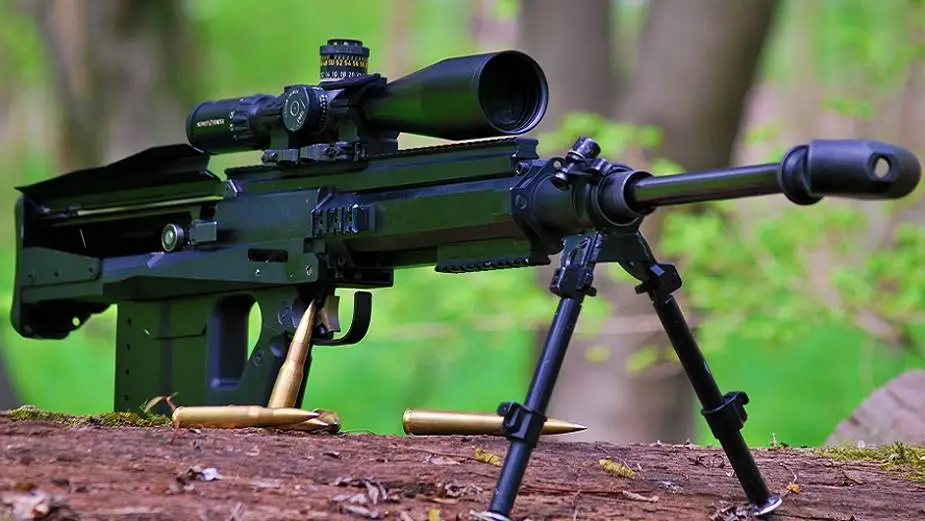Breaking news
British SAS highly satisfied with Hungarian Gepard GM6 Lynx anti-materiel rifles.
The Hungarian-made Gepard GM6 Lynx semi-automatic rifle worth £9,000 has a range of1.25 miles. According to the Daily Star, a British SAS member said: "The GM6 is fantastic! It’s like going into battle carrying an artillery piece. The troops call it the howitzer. It's an absolutely massive punch !"
Follow Army Recognition on Google News at this link

Gepard GM6 Lynx semi-automatic anti-materiel rifle (Picture source: Wikimedia)
The SAS, SBS, and the Special Reconnaissance Regiment are believed to have bought 150 of these rifles. They have already been deployed in Syria and Iraq.
The Gepárd anti-materiel rifles are a family of Hungarian weapons designed to destroy unarmored and lightly armored targets. These long-range, large-caliber rifles have high accuracy as well as high muzzle velocity. In 1987, the Hungarian army sought to obtain a compact, mobile weapon that could damage lightly armored targets. The project, led by Ferenc Földi (Institute of Military Technology of the Hungarian People's Army), culminated in the creation of the Gepárds.
The M1 was the first Gepárd rifle to enter service. It featured a long barrel for increased accuracy, a skeleton stock to reduce weight, and used the heavy 12.7x108mm cartridge. However, the rifle was complicated to reload. The M1 fired only one shot and would then have to be manually reloaded. To do this, the user had to rotate, pull back, remove the grip assembly (whose shape resembles a signal-flare handgun), and insert another cartridge. This tedious task took time to master and slowed the weapon's rate of fire. Other difficulties such as high recoil also plagued the M1. The recoil problem was solved with the addition of a barrel that recoiled back after each shot. The design was inspired by artillery cannons, which face the same impediment. Still, the Gepárd rifles need specially made, high-strength telescopic gunsights. Improvements, such as the addition of a carrier/lafette backpack and a longer barrel, led to the M1A1 variant, but at 21 kilograms its combat weight was deemed excessive.
The M1 was essentially a sniper weapon, not primarily intended for military field application, but for anti-terrorist police and special forces' use, who operate on the "one shot, one kill" principle. The single-shot action was designed to reduce the number of moving parts and allow for extreme precision, five hits out of five shots fit in a 25-centimeter radius circle at 1300 meters. Yet, the Hungarian army decided to purchase 25 rifles of the Gepárd M1 type for use as an in-the-field materiel destruction rifle but did not purchase any of the later variants so far. Owing to the great weight of Gepárd M1, sharpshooters were instructed to abandon the weapon if forced to retreat quickly and only save the grip assembly for proof, rendering the gun useless.
A semi-automatic version of the M1 was later produced. Dubbing it the M2, designers reduced its barrel length and weight. An even shorter paratrooper variant dubbed M2A2 made it more favorable to airborne forces and special forces, especially because it could be fired from the hip, thanks to the advanced recoil mechanism. A fiber optic technology scope and eyepiece imaging system was developed (or at least proposed) to allow the use of a hip-fired M2A2 for VIP protection purposes. Although the 12.7x108mm was considered one of the most powerful, Fellegi decided it was not good enough. He then ordered the development of the M3, with a larger 14.5x114mm. With this new destructive capability also came increased accuracy and range, making the M3 the most popular of the Gepárd rifles.
Nevertheless, three more models were to follow. The M4 and M5 sought to become improvements on the M2, with stronger materials and better reliability. The new versions have a more rectangular look and are usually of blackened steel finish, while M1 – M3 were usually painted olive-green color. Gepárd M5 is a bolt-action rifle for military sharpshooters and weighs only 13 kilograms, while the M4 is a semi-automatic anti-materiel rifle. The 10-round drum magazine, so characteristic of the M2 and M3, was replaced with a straight box magazine design with a capacity for five rounds. The later M4 and M5 can fire either Russian or NATO 12.7 mm ammunition as the gun barrel is field replaceable.
The M3 is strictly an anti-materiel rifle because, while the 14.5mm round is extremely powerful, its accuracy degrades rapidly at ranges beyond 1,000 meters. Its high destructive power is efficient in taking out hovering helicopters, APCs or mobile radar stations.
Finally, the Gepárd rifle family concluded with the M6. This rifle used the 12.7x108mm and .50 BMG rounds, like the M2 and M4, but featured stronger parts, lighter weight, shorter length and an improved scope.
The production history of the Gepárd was bumpy since it was designed and prototyped at the end of communist rule and the first production runs happened during the early-1990s, as Hungarian industrial capability shrunk in the process of transformation to the market economy. Early examples were assembled at the Vízgépészeti Vállalat (Hydrotechnic State Company). Production and development of Gepárd currently happen at Báthory-Épszolg Kft. (GM6 is manufactured by SERO Kft.), which also produces the new "Szép 7.62x51mm" bolt-action sniper rifle for the Hungarian army and anti-terrorist police units. This smaller, standard caliber sniper rifle owes a lot of design elements to the Gepárd, since its designer, Ferenc Szép, also participated in the development of the Gepárd guns.

Gepard GM6 Lynx semi-automatic anti-materiel rifle (Picture source: Wikimedia)



















